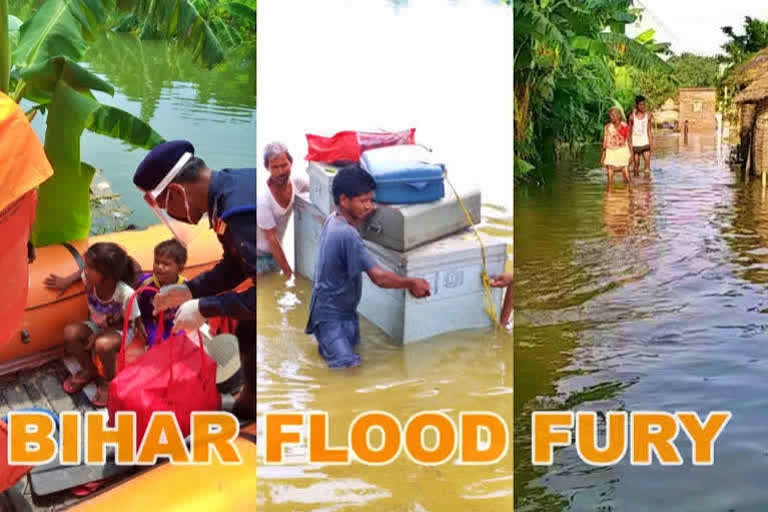Patna (Bihar): Havoc of floods in Bihar is an annual saga that brings devastation and misery to the people of the state. As monsoon has hit a few days back, the results are visible in the flood-prone districts of Bihar. The incessant rainfall in catchment areas of Nepal has created a flood situation in the West Champaran district. Above all the heavy discharge of water from the Gandak barrage at Valmikinagar has resulted in the rise of the water level of the Gandak river. On Tuesday, around 4.4 lakh cusec water was released from the Valmikinagar Gandak barrage after which the administration has issued an alert to protect the embankment in the concerned districts.
Chief Minister Nitish Kumar had called a high-level review meeting on Tuesday and had ordered to ensure that all the flood protection work is completed. Nitish had categorically asked the district magistrates of East Champaran, West Champaran and Gopalganj to keep a close eye and continuously monitor the flood situation. Even the met department and the central water commission (CWC) issued warnings for the heavy and flood prediction respectively. As per CWC rivers like Gandak and Burhi Gandak are flowing above their danger level. According to an official advisory, the CWC Gandak river at Dumrighat in Gopalganj district was flowing at 62.4m with a rising trend. Similarly, Burhi Gandak at Chanpatia in West Champaran district is flowing above danger level with a rising trend.
Read: 25 lakh people displaced by Bihar floods, 8 dead
Similarly, the met department had issued a warning of heavy rain for the next 48 hours and sounded alert in districts like Madhubani, Sitamarhi, Darbhanga, Sheohar, Supaul, Kishanganj, Purnea, Araria and Siwan. Asked about the measures being taken by the government amid the flood situation in the state, water resources department minister Sanjay Jha told ETV Bharat over the phone that all preventive steps have been taken.
"As you know that Bihar faces floods every year due to the heavy rainfall in the catchment area of Nepal. There is no permanent solution until the high rise dam is built on the Nepal side. The talk of the DPR of a high rise dam in Nepal has been pending since 2004. So far no conclusive talk has taken place between the centre and the Nepal government. However, we have completed all the preventive measures despite facing several challenges in covid times," Jha said.
Read: Woman delivers baby on NDRF boat in flood-hit Bihar
Jha further added, “Many contractors and engineers of our department had got infected with this deadly disease and some even lost their life. Despite that, we ensured that all the work related to soil erosion and strengthening of the embankment is completed on time. We cannot stop the rain but with the help of a new mechanism that provides us 72 hours, early alerts of rain give us ample time to take preventive measures. We are also coordinating with the disaster management department to ensure that relief materials reach the needy people on time.”
Meanwhile, the state disaster response force (SDRF) and national disaster response force (NDRF) have been deployed at the flood area. Bihar has 16 flood-prone districts and every year lakhs of people lose their homes and livelihood. Last year 7.54 lakh hectares of agricultural land was destroyed due to flood and around 139 people had lost their lives. Bihar has faced the worst devastation when Kosi breached its embankment at Kusaha in Nepal on August 18, 2008. The Kosi flood had marooned as many as five districts- Saharsa, Purnea, Madhepura, Araria and Supaul.
Read: Villagers of flood-hit Muraul block to file case against administration
The Bihar government had announced the Kosi 2008 flood as a national disaster in which 527 people had lost their lives. The floodwaters had swept away more than 300,000 houses in 980 villages in five districts and had destroyed paddy crops, wheat and vegetables in 110,000 hectares of fertile land. An estimated 3.2 million people had lost their homes and livelihood. In recent history, such a number of people have not been affected by any natural disaster in the country. Kosi is one of the major tributaries of the Ganga and is often called the "Sorrow of Bihar".



